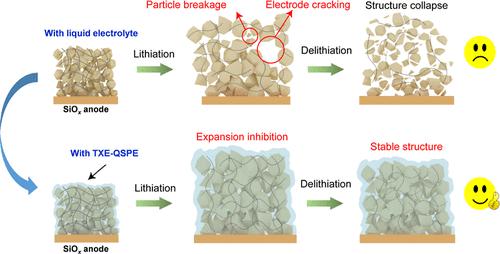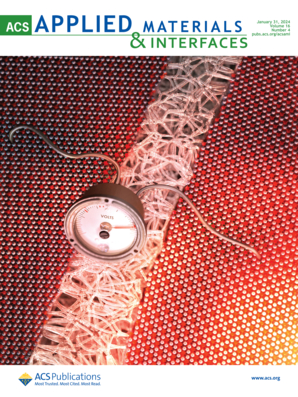Stabilizing the SiOx Anode by a Highly Elastic Quasi-Solid Polyether-Based Electrolyte via an In Situ Fabrication
IF 8.3
2区 材料科学
Q1 MATERIALS SCIENCE, MULTIDISCIPLINARY
引用次数: 0
Abstract
Silicon monoxide (SiOx, x ≈ 1) has been a promising candidate of anode materials for next-generation lithium-ion batteries due to its high specific capacity (∼2600 mA h g–1). However, huge volume expansion and the resultant repeated destruction of the solid electrolyte interphase (SEI) are key challenges to the practical application of the SiOx anode. In this work, a highly elastic quasi-solid polymer electrolyte (QSPE) is demonstrated for batteries employing an SiOx anode, which is prepared via in situ cationic ring-opening polymerization employing 1,3,5-trioxane (TXE) as the monomer, 1,3,2-dioxathiolane 2,2-dioxide (DTD) as both the initiator and film-forming additive, and fluoroethylene carbonate as the plasticizer. This TXE-based QSPE possesses excellent ionic conductvity properties, including an extremely low glass-transition temperature of −94.3 °C, a high ionic conductivity of 1.36 mS cm–1 at 25 °C, and a high Li+ transference number of 0.66. The long poly-TXE skeleton endows the polymer electrolyte with a high elastic modulus of 42 MPa, helping to effectively suppress the volume expansion of the SiOx anode during cycling. DTD participates in the construction of a robust SEI containing Li2SOx species, mitigating the structural collapse of SiOx particles. As a result, the cyclic stability of the SiOx anode has been remarkably enhanced─the Li||SiOx half-battery with the in situ TXE-based QSPE achieves 81.9% capacity retention after 200 cycles at 0.5C, exhibiting significant improvement over its liquid-state counterparts and showing promising application potential.

求助全文
约1分钟内获得全文
求助全文
来源期刊

ACS Applied Materials & Interfaces
工程技术-材料科学:综合
CiteScore
16.00
自引率
6.30%
发文量
4978
审稿时长
1.8 months
期刊介绍:
ACS Applied Materials & Interfaces is a leading interdisciplinary journal that brings together chemists, engineers, physicists, and biologists to explore the development and utilization of newly-discovered materials and interfacial processes for specific applications. Our journal has experienced remarkable growth since its establishment in 2009, both in terms of the number of articles published and the impact of the research showcased. We are proud to foster a truly global community, with the majority of published articles originating from outside the United States, reflecting the rapid growth of applied research worldwide.
 求助内容:
求助内容: 应助结果提醒方式:
应助结果提醒方式:


